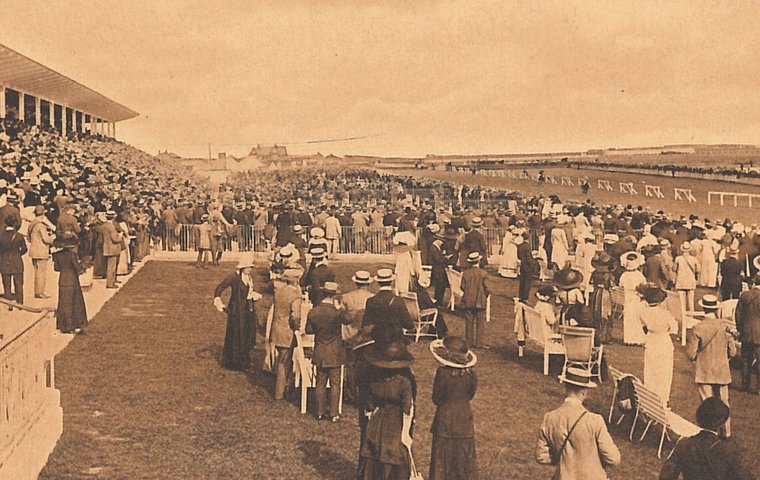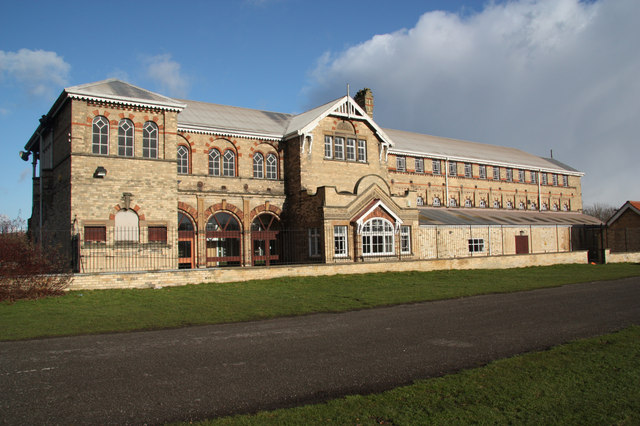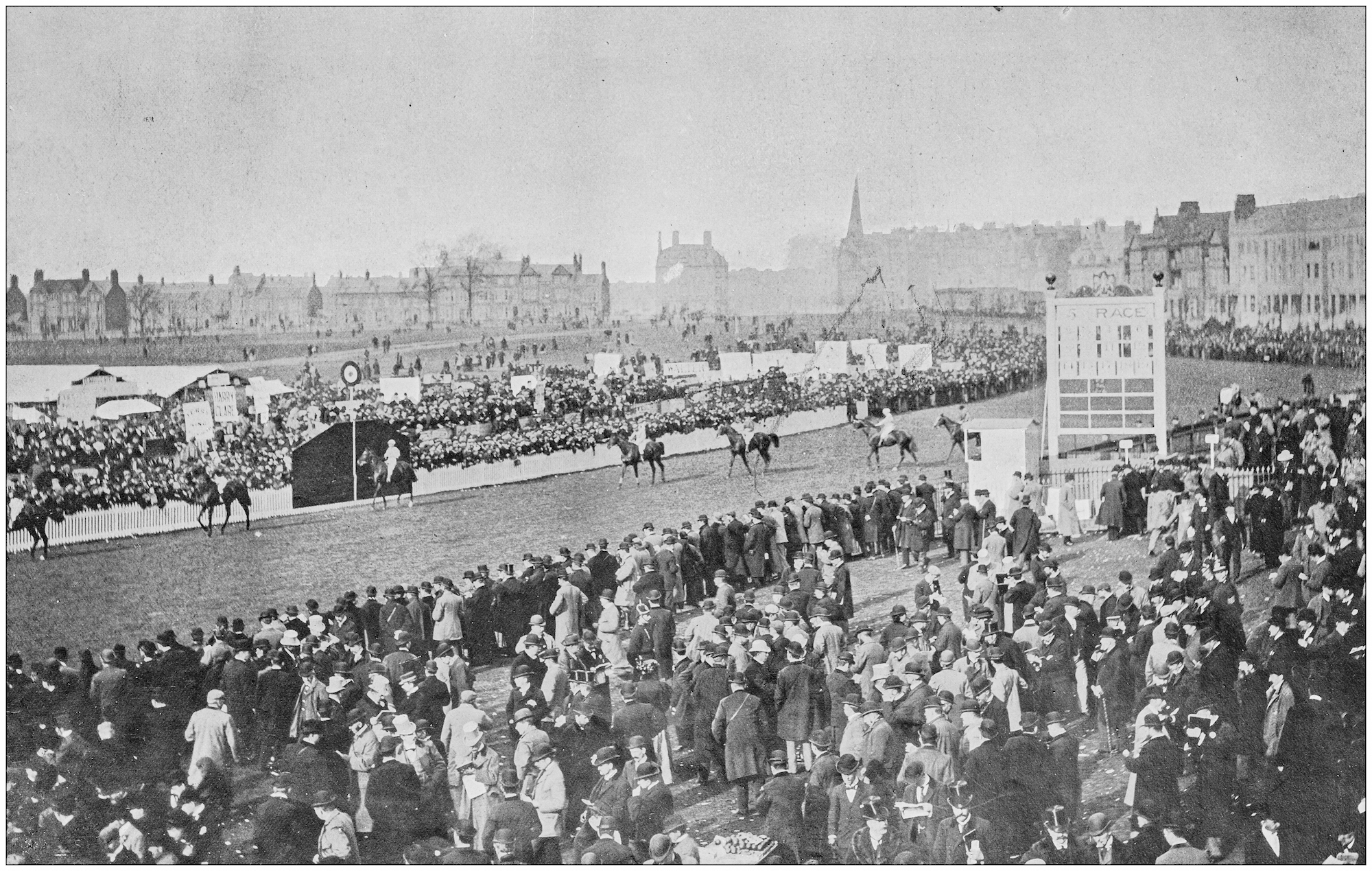
Racecourses across England were shuttered this spring, their empty grandstands echoing above pristine turf, unchurned by pounding hooves. Racing resumed in June, behind closed doors for the time being, and the industry busily prepares plans to open its doors to eager spectators.
This time of pause and reflection is a suitable moment to look back at England’s Thoroughbred racing history and remember some of the racecourses, once clamorous with panting horses and cheering crowds, that have long-since closed. This article tells the story of three of them, at Lincoln, Northampton and Blackpool.
Clifton Park, Blackpool (1911 – 1915)
The history of the racecourse at Clifton Park is a tale of hubris, folly and plain bad luck.
Opening in 1911 with a summer meeting intended to catch the tourist trade, and feted as ‘the English Auteuil’, Clifton Park seemed a sure bet. But within three years the track was in receivership, and come 1915 it had closed.
The track, built on a leased airfield by an enthusiastic syndicate of backers, sprung up quickly. Money was poured into the venture. The track could accommodate 25,000 people, with 2,000 in a members’ stand and 3,000 in another. The proprietors hired the staff from Hurst Park racecourse in Surrey to build the fences for the steeplechase course, on a flat oval just over one mile and a half round.
The press was generous with its praise. TheWest Lancashire Gazette declared that, with “the favourable consideration of several of the most important owners and trainers and with such powerful backing, the success of the new scheme is virtually assured”.
The Daily Sketch mused that the track “should turn out to be a gold mine for its promoters”, while TheTelegraph prophesied a “great future” for Clifton Park. They couldn’t have been more wrong.
The first season at Clifton Park got off to a strong start. Its opening meeting, three days at the start of August, was hailed as a “brilliant beginning”, drawing crowds of over 20,000 and many of racing’s great and good.
Prizes were high, attracting large fields and making for interesting racing. However, meetings later in August failed to repeat this success. The track proved difficult to maintain and a railway strike prevented many from attending.
In an attempt to boost its fortunes, Clifton Park moved the following year’s meetings to coincide with the traditional jumps season. But fields were disappointing as much-reduced prize money failed to attract many runners, and attendance figures crashed.
A meeting in March was cancelled due to another strike, this time by the coal industry.
This downward spiral continued over the next two years: the Clifton Park Racecourses Syndicate had dramatically overestimated the audiences they might attract; the course was over-reliant on erratic infrastructure; and it could not sustain the prize pots required to support good racing.
The outbreak of war in July 1914 was the last straw. The final days of racing took place in 1915, but soon after the site was requisitioned by the military, and the course closed down.
Racing never returned to Blackpool, despite several attempts. The tale of Clifton Park, that over-ambitious and poorly planned ‘gold mine’, serves as a warning.
Lincoln Racecourse (1773 – 1964)

Known for its spectacular Gothic cathedral and castle complex, the ancient city of Lincoln has been settled since Roman times. The earliest records of racing there date back to February 1597, when, as the city registers state, the Mayor called ‘for a scaffold at the horse race to be allowed’.
The first known site for racing was south of the city at Lincoln Heath, which was visited by James I, one of England’s racing royals, in April 1617.
In 1773, the focus shifted to the west of the city, on an open common at Carholme. Watched over by the triple towers of the cathedral, racing started at this auspicious site in the second week of September that year, with one race each day from Wednesday to Friday.
Racing at Lincoln was popular, so much so that a permanent grandstand was erected in 1826 at the southeast corner of the track. A two-storey building constructed in the classical style, the grandstand had a raised balcony wrapped around its first floor, accessed through an elegant glazed arcade. Three years later a second stand, a simple tier of raked seating, was erected nearby.
But racing could be a disorderly business. In 1828, one newspaper reported that 500 ‘thieves, prostitutes and gamblers’ had attended the recent races, and lawless behaviour, brawling and drunkenness were common during and after the event (scenes no modern fan will recognise).
In 1831, things came to a head. Riots broke out when local people, enraged by the cheating of the professional gamblers, attacked the crooked ‘thimble-riggers’, determined to take back their money. Around 50 gentlemen and fox-hunting farmers soon joined in, and the gamblers fled for their lives.
Christopher Turnor and John Fardell, two stewards from the course, were awarded a large silver presentation bowl in recognition of their services to the Turf that year. It is tempting to imagine what they did that day to earn such an honour but that, alas, is lost to history.
Lincoln soon shed its unruly reputation and, by the middle of the 19th century, it hosted several important meetings each year, notably the Lincolnshire Handicap and the Brocklesby Stakes.
Attendance grew, and by the end of the century the Lincoln calendar had grown to three meetings a year.
In 1897, a new grandstand was erected to the south east of the existing buildings, and a five-shilling ring was installed. Designed by local architect W Mortimer and Sons, the grandstand was built from brick with a corrugated iron roof and cast iron and stone piers. With a single tier of raked seating under a canopy, the Victorian building was neo-Romanesque in design, featuring round-headed, paired windows and expressive, colourful brickwork.
Racing at Lincoln followed the fortunes of the first half of the 20th century and, like many tracks, it never really recovered after the Second World War.
By the 1960s, the cost of maintaining a racecourse had become untenable. In 1963, the Levy Board, which distributed the proceeds of on-track betting to racecourses across the country, resolved to withdraw its financial support for Lincoln. A year later the City Council also stopped funding the track.
The racecourse, which had been held under lease by the Lincoln City Corporation since 1939, had nowhere to turn.
The Lincolnshire, now known simply as the Lincoln Handicap, and the Brocklesby have been run at Doncaster, 32 miles away, since 1965. They are feature races at what is traditionally the first turf meeting of the British flat season every March.
Yet racing limped on. From 1967, several point-to-point meets were held, and in 1983 the City Council renovated the grandstand, replacing the leaking roof and installing a new kitchen and bar. But, in 1991, an ultimatum was served. The local council, staunchly opposed to hunting, would only ratify the point-to-point events if the riders wore no hunting garb, and if the money raised was donated to causes other than the National Hunt.
Needless to say, no further races were run.
Northampton Racecourse (1737 – 1904)

Although there has been no Thoroughbred racing in Northampton for over a century, you might be forgiven for thinking that racing still had a home in the city.
Glance at any map of Northampton and ‘The Racecourse’, a large swath of green close to the city centre, is immediately clear. Now the home of Sunday afternoon sports, a medieval-themed restaurant in its refitted grandstand, the park betrays little of its history.
Formal racing began in Northampton in 1632, when William, Lord Spencer, called a meeting on an open site to the north east of the city. At around this time, informal races were also held at The Racecourse site. It was an ad hoc affair, with events only made official in 1737.
An early visitor to The Racecourse would have had a very different experience depending on which time of the year he or she arrived. Yes, racing was held in the autumn and the spring, but between November and February the track was used for grazing sheep. Visit on the wrong day and you would find yourself caught up in a baying crowd, gathered to jeer at one of the public executions held at The Racecourse between 1715 and 1818.
Come the 19th century, racing at Northampton was more firmly established. A medal struck in 1830 shows the early grandstand built there. Two storeys tall, the building had a cast-iron balcony across the length of its first floor, with railings above.
As the years progressed, Northampton’s prestige grew, attracting a large aristocratic following and royal patronage.
In 1844, a new grandstand was erected to the left of the first, at a cost of more than £2,000. This was a much larger structure, with a first-floor balcony and raked seating set on the roof above. To control disorderly conduct, a temporary jail was built adjoining the grandstand (with, it is tempting to imagine, a clear view of the home straight).
The occasional scuffle aside, Northampton’s main problems concerned the track itself. The public held grazing rights until 1882, and it was unfenced. Spectators wandered over the track on racedays and accidents were common. This was compounded by the layout of the course itself, which was a mile and a half in length and squeezed onto a small site. Only wooden posts marked the tight corners, and a wily tactic was to force rivals off the course at the bends.
Disregard for safety spelled the racecourse’s doom. On the second day of the Spring Meeting in March 1904, during the Kelmarsh Selling Plate, a horse slipped on a section of loose turf and thundered into the crowd. The stewards of the Jockey Club, investigating the incident, concluded that the course was too dangerous for racing and withdrew permission for any further meetings. The autumn events were cancelled and no alternative venue could be found.
There would be no more racing in Northampton.
Sources
Chris Pitt, A Long Time Gone (Portway Press, 2006)
Lincoln
Richard Gurnham, Nymphs of the Pavement: Sin, Scandals and Vice in Victorian Lincolnshire, (The History Press, 2014)
‘The rich history of horse racing in Lincoln…’, Lincolnshire Echo, 5 January 2013 (http://www.lincolnshireecho.co.uk/rich-history-horse-racing-Lincoln/story-17747042-detail/story.html )
The National Horse Racing Museum, ‘Remember Lincoln Racecourse?’, 19 March 2010 (http://blog.nhrm.co.uk/index.php/remember-lincoln-its-still-there/)
Northampton
Tony Doyle, ‘The Racecourse’. Online, available: http://paintedpixels.co.uk/northampton/northampton/racecourse.html
‘The borough of Northampton: Introduction’, from A History of the County of Northampton: Volume 3, (Victoria County History, London, 1930), pp. 1-26
Blackpool
IanS, ‘Clifton Park, Blackpool’, Geezgeez (http://www.geegeez.co.uk/lost-racecourses-8-clifton-park-blackpool/)


